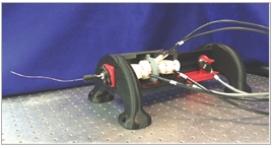Intraoperative MRI-Guided Robotically-Steerable Needles
Researchers affiliated with the Center for Compact and Efficient Fluid Power (CCEFP), an NSF-funded Engineering Research Center (ERC) headquartered at the University of Minnesota, have developed a fluid powered actuator module that functions as a two-degree-of-freedom needle driver. The device is intrinsically safe and can be sterilized.
This innovative actuator can enable intraoperative, robotically steerable needles guided by magnetic resonance imaging (MRI) machines. The device overcomes a technical barrier to using fluid power in MRI-guided surgical systems; that barrier was prior absence of commercial off-the-shelf fluid power actuators that are both safe and sterilizable.
Fluid power actuators (hydraulic and pneumatic) are well suited for electromagnetically sensitive environments like MRI machines. Researchers at Vanderbilt University and Milwaukee School of Engineering designed and built an additively manufactured pneumatic stepper actuator in which bellows directly translate and rotate the base of one tube of a steerable needle.
The design uses corrugated diaphragm theory, one helix-shaped bellows, and one toroid-shaped bellows to provide pure rotation and pure translation, respectively. Several of these modules can be cascaded together as a complete actuation unit for steerable needles comprising multiple, concentric tubes.
For needle tip translations and rotations, mechanical stops limit the bellows’ movements to maximum unplanned step sizes of 0.5 mm and 0.5 degrees, which are acceptably safe in the event of a system failure. Additively manufactured by laser sintering of nylon powder, the prototype device is compact and hermetically sealed for sterilizability.
The linear bellows produced peak forces of 7.4 lbf and -6.0 lbf for needle insertion and retraction, respectively, and the rotary bellows produced peak torques of ±0.60 lbf-in. A precision, sub-step controller allows translations and rotations less than full step increments; steady-state errors of 0.013 mm and 0.29 degrees were achieved with the prototype (see figure).


